- What’s On
- Exhibitions
- The Churchie Emerging Art Prize 2025

The Churchie Emerging Art Prize 2025
Exceptional emerging artists from across Australia
Dates
26 Jul - 9 Aug 2025Galleries
Gallery OneGallery Two
Window Gallery
New Benner Theatre
Gallery Open Hours
- Monday – Friday | 10:00am – 4:00pm
- Saturday | 12:00pm – 4:00pm
The galleries are closed Sundays and public holidays.
Times subject to change.
Free Special Events @ Metro Arts
Exhibition Opening Event and Prize Announcement
- Friday, 25 July| 6:00pm
Exhibition Catalogue
Read the exhibition catalogue here:
READ CATALOGUE
Australia’s most diverse art prize for emerging contemporary artists, the churchie emerging art prize (‘the churchie’) returns in partnership with Metro Arts for its second year.
Now in its 38th year, ‘the churchie’ is Australia’s longest-running prize for emerging artists and provides an exceptional platform for career opportunities, education, and direct engagement with the broader arts community.
‘the churchie is open to all emerging Australian artists over 18, regardless of their artistic practice or medium. The prize has played a significant role in launching the careers of some of Australia’s renowned artists. Each year, emerging artists from across the country are selected for the finalists exhibition, showcasing a diverse range of innovative and contemporary artworks.
Exhibition Opening and Prize Announcement: 6 – 8pm, 25 July 2025
Finalists Exhibition: 26 July to 9 August 2025
Exhibition Documentation
The artists
Myran Alden

Myarn Alden is a Kija, Jaru and Ngarti woman from the East Kimberly, Halls Creek, Kununurra and Fitzroy Crossing. Relocating to Adelaide for schooling since 2020, Myarn is both a practising artist and a Studio/Gallery Assistant at the APY Art Centre Collective in Adelaide.
I was taught how to paint as a young child by my Kumputu (Great Grandmother) Biddy Timbinah, a Jaru, Walmajarri, and Ngarti woman. Kumputu painted the powerful story of her journey walking twelve hundred kilometers through the Western Desert near Kiwirrkurra, to Sturt Creek Station near Halls Creek, barefoot, with her sisters and her three mothers. I now carry on her story through my painting, as well as some of my own dreaming about the galah and the cockatoo, two powerful spirits in conflict over the land. In my work, their struggle is represented through the channel of water that divides the land, symbolizing tension, change, and the ongoing question of rightful belonging. The land itself speaks in these moments, layered in memory, divided in experience, but always connected through culture.
I continue to use the Western Desert painting style taught to me by my Kumputu. Through the layered dots and shifting patterns represent the changing rhythms of Country, its harshness and movement. Each mark and layer hold story, generations, history, and our identity. I utilize the different range of reds to represent the rich pindan soil that covers the Kimberly land. A powerful story that I tell through this land is the protection that the land has provided my people. During the time when the government was taking children away, my kumputu and her family used the land to shield their young ones. They would
Tiarnie Edwards
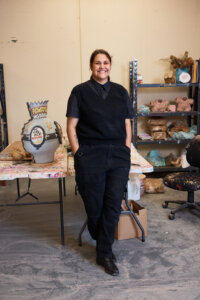
Tiarnie Edwards is a Ngarrindjeri artist born in Kaurna Yarta in 1998. Raised on Nauo Country in the Lower Eyre Peninsula, they grew up in the small seaside community of Tulka. By the end of 2020, they moved back to Kaurna Country to study a Bachelor of Contemporary Art at the University of South Australia, graduating in 2023, and going on to participate in the 2024 Helpmann Graduate Exhibition, as well as the Hatched 2024 Graduate Exhibition at the Perth Institute of Contemporary Art.
Tiarnie started working with ceramics in 2022 for the first time whilst studying at university, and ceramics have become a core focus of their artwork. Their practice focuses on themes of identity, culture, history, politics, and activism, and the intersectional way these fields overlap within complex and diverse identities within contemporary Australian life, particularly Aboriginal Identities. Blak Bone highlights historical events and icons from Indigenous history in so-called Australia, encapsulated within the adorned weight of jewels that represent the crown and monarchy that governs over Australia. Events like the Pilbara Strike, a significant shift in progress for both Aboriginal and workers’ rights, are highlighted by the iconic phrase “the men marched down the road like thunder”; the historic movement by Aboriginal workers cemented Aboriginal rights movements as the backbone of many a liberation front. Blak Bone tells the story of Aboriginal resistance in a contemporary time, and how Aboriginal struggle and liberation benefit wider Australian life as well, from workers’ rights, land rights, wealth equity, and abolition, the foundation of Indigenous struggle is progress for all, not the few.
The use of the crown as a symbol of both the monarch and stolen wealth is reclaimed by the icons of Aboriginal resistance, such as Gary Foley and Lidia Thorpe, who are a part of the long-standing legacies of colonial resistance and Aboriginal Sovereignty movements. I made this vessel as an ode to those often forgotten and erased, whilst colonial statues stand, to Aboriginal peoples who have laid the foundations for a thriving Aboriginal future and whose blood is the backbone of every progress made wider in this country.
Bianca Tainsh
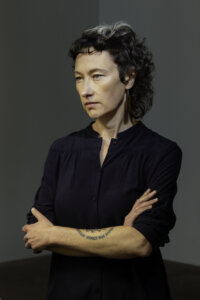
Bianca Tainsh is a Meanjin/Brisbane-based artist. Through a hybrid practice of open-disciplinary art and fluid forms of ecological activity, her work proposes new avenues for the cyber-saturated human to re-entangle with natural realities, often exploring our own state of being as interdependent, multi-species bodies.
Bianca holds a 1st Class Honours from RMIT University and has undertaken postgraduate studies at the Victorian College of the Arts. She has exhibited at Outer Space, Blindside, SomoS (Berlin) and Kings ARI. She won the 2021 Regional Art Awards New Media Award and has presented a TEDx talk, “Art: Creating unique spaces for social transformation”.
My projects evolve through deep, multi-form investigations that seek to map a blueprint exposing the fabrications shaping generic human existence. Fortified by a metaphysical interconnection with the more-than-human world and the perceived rationality of science, I shape provocations intended to destabilise institutional and societal dogma. These provocations become frameworks for collaborative endeavours with the more-than-human, scientists, engineers, and other creatives.
My work spans video, digital, and semi-traditional media, sculpture, and live art. I often relinquish my works to the entropic forces of the more-than-human, who then define the outcomes.
The first chapter of my current research project was catalysed by the provocation: As an interspecies communication network, could fungi be a portal for communing with nature?
Following a mycological partnership to learn how to propagate mycorrhizal fungi, I created Myc-a, a living artwork – what I have come to call a ‘terra-biome’ – composed of flora and microfauna interconnected by fungal networks.
To create an initial surge of fungal growth within Myc-a, syncing and fusing the species assembled within, a Ritual for Entanglement was performed at Outer Space gallery, Brisbane. The audience convened in a vocal act of collective procreation, bringing Myc-a into being. Since this genesis, interactions with Myc-a have generated a musical score, poetry, and improvisational choreography.
Myc-a is more than a sculpture; they are a practice of mutualism and perpetuity, embodying the intelligence and memory of place. All organisms were respectfully collected from my family’s nature refuge on Lake Weyba, Kabi Kabi Country, making Myc-a a vessel of biocultural knowledge.
Through a current Metro Arts residency, I am developing a body of work exploring terra-biome culture for exhibition in August 2025. I am also working with engineers at the University of Queensland to develop a machine learning entity capable of deciphering the electrical communications of underground fungal networks.
Grace Stevenson
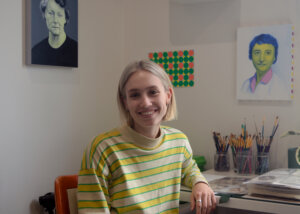
Grace Stevenson is an emerging painter living and working in Naarm (Melbourne). Her work explores the complexities of identity through photography and portraiture. Predominantly sourced from 19th and 20th century collections, Stevenson’s work is inspired by sourced portrait photographs of anonymous individuals. Her uncanny paintings create an alternate vision of portraiture, challenging the inauthenticity of the portrait as a representation of identity. The way Stevenson collects, references, and re-presents photography through painting constantly provides her with ongoing opportunities to question and reinvent the boundaries of understanding and expressing identity.
On graduating with Honours of Fine Arts from the Victorian College of the Arts, Stevenson was awarded the ARC ONE Artist Opportunity, where she exhibited her work with ARC ONE Gallery. She has also exhibited with several other galleries in Melbourne, including Sorse Gallery, Fortyfivedownstairs, Brunswick Street Gallery, and George Paton Gallery.
The Imposture is an ongoing painting series inspired by found photographs of anonymous individuals. Stevenson draws on ideas from Roland Barthes’ book, Camera Lucida, to question the authenticity of the photographic image, proposing that every photograph involves an element of performance, or what Barthes calls “imposture.”
Barthes takes this idea to extremes when he sums up the experience: “In front of the lens, I am at the same time: the one I think I am, the one I want others to think I am, the one the photographer thinks I am, and the one he makes use of to exhibit his art. In other words, a strange action: I do not stop imitating myself, and because of this, each time I am (or let myself be) photographed, I invariably suffer from a sensation of inauthenticity, sometimes of imposture.” (Barthes, 1981, p. 13)
Hidden throughout the body of work are doppelgänger-like features across multiple portraits. For instance, in The Imposture #11 and #16, the subjects share the same eyes. Although we typically view portraits as offering insight into the sitter’s identity, these works expose the inauthenticity of a portrait as a representation of identity.
Although Stevenson’s work reveals a certain veracity, each subject is concealed by a vivid, alien-green mask. These masks symbolize the imposture within – that unfamiliar self we often attempt to conceal. The mask is inevitable in a portrait; we all wear a mask in a photo as our body stiffens into an image. Thus, the mask in Stevenson’s paintings is a symbolic one, created by the camera, and represented through the paintings in the form of a glazed colour, bringing a different kind of self forward, and into question. Rather than creating falsehoods, the masks invite reflection on identity, authenticity, and the performative nature of self-representation. In the final analysis, the work invites its audience to confront and accept their inner aliens as paths toward more inclusive understandings of identity, and ultimately, their realities.
Ruth Ju-shih Li
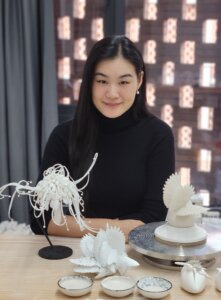
Ruth Ju-shih Li is a Taiwanese-Australian artist working across sculpture, site-specific installation and ephemeral methodologies. Her practice explores memory, impermanence, and the shared human experience through material transformation. Working with raw clay, porcelain, wax, and organic matter in transitional states, she creates ephemeral works that invite reflection, reimagination, and cross-cultural dialogue. Li has exhibited widely in Australia and internationally, with solo exhibitions at MARS Gallery (AU), VERGE Gallery (AU) and Tsing Hua University Gallery (TW). She has participated in residencies across Asia and Australia, and her work has been recognised through awards, publications, and institutional exhibitions.
As an emerging Taiwanese-Australian artist, my practice reflects a deep engagement with cultural heritage, spirituality, and cross-cultural dialogue. Autobiographical in nature, my work explores impermanence, renewal, and the shared human experience. I create sculptures and site-specific ephemeral installations, held briefly in form—often working in situ with raw materials in their transitional states, inviting change: to soften, to collapse, to return to the earth. My practice exists in these liminal moments—not as objects of preservation, but as gestures of impermanence.
Built around a single cotton thread, the wax sculptures rest in stillness, awaiting activation. Blooming in imagined flora drawn from childhood memories, they speak in the universal language of flowers. These chimerical microcosms of organic forms are self-portraits yet mirror the transitory nature of the human condition, embodying an ongoing process of becoming and its ambiguous ontological state of flux. The work flourishes, fluctuates, and decays, releasing the natural scent of sandalwood—an offering that echoes my grandmother’s home in Taipei, where incense once curled through the rooms. The scent becomes a thread to the past, to spirit, to family.
Over time, the remnants are gathered, recycled, and folded into new works – an ongoing cycle of transformation, with each iteration carrying traces of the last. Informed by cultural identity and shaped through ritual, this work embraces impermanence not as loss, but as transformation. It is both sculpture and performance, stable and dissolving, personal and universal. Time becomes both material and collaborator, guiding the sculpture’s slow unmaking—a quiet ritual that honours grief, ancestry, fragility, cycles of renewal and beauty in flux.
By embracing the ephemeral and the cyclical, my practice resists monumental forms of sculpture in favour of vulnerability and intimacy. I am interested in the ways the body remembers across generations and how ephemeral processes can become gestures of resilience, creating space for healing and reimagination. Each work becomes part of an ongoing conversation with material, with memory, and with those who encounter it.
Slow, cyclical, and alive.
Melissa Nguyen

Melissa Nguyen is a Vietnamese Australian artist living and working in Melbourne/Naarm. Her painting-based practice explores the multiplicities of translation as a creative methodology. Through examination of cultural dissonance and positionality as part of the Vietnamese diaspora, Melissa dissects the complex relationship between copy and original. Melissa’s practice takes ‘self-Orientalism’ as a conceptual framework through which she questions the relevance of cultural identity in art.
Melissa completed her Bachelor of Fine Arts (Honours) in 2022 at the Victorian College of the Arts and has since exhibited both nationally and internationally; spaces including Mary Cherry Contemporary, West Space, Bus Projects, TCB Art Inc., Conners Conners, and ISA Art Gallery. She was also a finalist at the Castlemaine Experimental Print Prize in 2021.
Royal Bloodlines is based on an image discovered at the Imperial Citadel in Huế, Vietnam – a photograph of a royal concubine of Emperor Thành Thái. An uncanny similarity between myself and this historical figure opened for contemplation of possible ancestral connections, and the blending of personal narratives with the layered complexities of cultural identity. As a Vietnamese Australian growing up immersed in Western culture, I often feel disconnected from my own culture, and this painting becomes an affirmation of my Vietnamese heritage. The resemblance between myself and the royal concubine serves as both a visual and symbolic link to my culture, reaffirming the validity of my identity despite the diasporic dissonance.
Jorge Marino Brito

Jorge Mariño Brito is a Cuban-born artist now living in Meanjin (Brisbane). His diverse artistic practice incorporates contemporary painting, papermaking, and printmaking. With a background in psychiatry, Brito draws from his experiences with Latin American communities, confronting the complexities of navigating different cultures while aiming to create safe spaces through his art. Brito’s contributions to contemporary art were recognised when he received the Iain Memorial Turnbull Award and the Grey Hand Press Internship in 2023. He held his first solo exhibition, This Intimate Life, at Grey Street Gallery in 2024, was a finalist for the Sydney Contemporary MA Art Prize, and was awarded Best in Show at Queensland College of Art and Design that same year.
Untitled (Figures and Space III) is part of an ongoing series that draws on the emotional resonance of vintage photographs to investigate the nuances of male closeness and intimacy, informed by Brito’s research into how men express connection beyond conventional stereotypes.
Themes of touch, vulnerability, and presence are captured on life-sized canvases and gestural brush strokes to challenge the often sexualised or competitive portrayals of male intimacy prevalent in cultural narratives. Instead, Brito presents scenes where care, trust, and embodied connection take precedence.
By situating these figures in ambiguous environments, Brito captures the comfort and tension inherent in male relationships, prompting viewers to reconsider the boundaries of affection and emotional openness. His expanded definition of intimacy highlights men’s need for connection, showcasing how physical closeness, through everyday activities of kinship, can stimulate emotional exchanges. Through his work, Brito invites audiences to reflect on the nuanced ways men relate to each other, fostering a dialogue about vulnerability and care in male friendships.
More broadly, Brito’s work addresses the growing tactile deficit, or deprivation of touch, in an increasingly digital culture where visual speed and frictionless surfaces have led to a separation between bodies, materials, and memory. At the same time, it responds to the restrictive ways that male closeness and touch have been represented in art history, creating new interpretive opportunities for the representation of men and male closeness in art that engages with concepts of identity politics. The invitation to explore memory and presence through touch and sight fosters a more nuanced, inclusive, and emotionally rich experience for diverse audiences.
Rosemary Lee
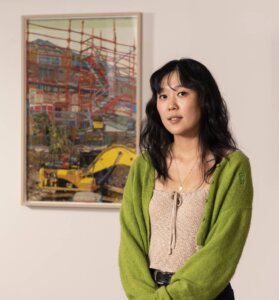
Rosemary Lee is a Sydney-based artist. She received a bachelor’s degree in fine art from the National Art School in 2018. Lee was the winner of the Dobell Drawing Prize, Megalo residency, William Fletcher grant for drawing, Clyde and Co. art award, and ADFAS residency. She received the highly commended award in the Tony White Memorial and has been selected as a finalist in the Portia Geach Memorial, Lester portrait prize, Brett Whiteley Travelling Scholarship, and more. Lee is currently represented by Flinders Street Gallery.
Rosemary Lee’s work consists of detailed coloured pencil, graphite, and charcoal drawings that convey her hometown of Ashfield, Sydney, in the form of urban landscapes and still life’s. She renders her work as if they were paintings, covering every surface of the paper with pigment. She conveys the intricacies of urban sites and local flora through a focus on detail and colour. Blending an array of styles, her work creates a sense of drama, chaos and depth in often commonplace settings and passing moments.
Sophie Lampert
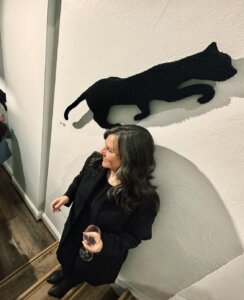
Sophie Lampert completed a Master of Fine Art at The National Art School in Darlinghurst, 2020. She has participated in numerous group exhibitions, most recently in Plausible Playground, Macquarie University. She was awarded ‘The Seed’, holding a solo exhibition at the Orange Regional Gallery, and was awarded second at the Gosford Art Prize (2023). Lampert has been a finalist in the Tom Bass Prize, Woollahra Small Sculpture Prize, Fishers Ghost Art Award, North Sydney Art Prize, and National Capital Art Prize. She is currently developing a solo exhibition based on research conducted during her 2024 residency at the Cité Internationale des Arts in Paris.
Exploring the atypical vocations of a number of female figures throughout history is the concept that that underpins my sculptural practice. I investigate the lives of women whose biographies reveal an oscillation between their engagement in mundane socially prescribed activities, and paradoxically a career that defied the confines imposed because of their gender.
From a contemporary perspective, the concepts that drive the sculptures are a starting point from which to understand current issues responsible for gender bias and cultural stereotypes pertaining to the female experience. My work does not locate itself within the masculine canon, rejecting associations with traditional materials to explore the genre of abstract portraiture.
One such figure is Elisabeth Catherina Koopmann, b1647, one of the first female astronomers. After her husband’s death, she completed and published their catalogue of 1,564 stars, Prodromus Astronomiae, in 1690. ‘Through her lens’ is the imagined view of the night sky from Elisabeth Hevelius’ perspective. In history, the lens has been skewed to focus on the achievements of a privileged few. However, by adjusting the lens, it is possible to appreciate the achievements of others who have not been elevated by historical editing to the status of ‘the great men of science’.
Through my creative process, I explore concepts that challenge historical narratives while physically manipulating non-traditional materials. The individual pieces celebrate the history of textiles and craft, which is embedded in the female experience. Yet, they also encourage us to consider how access to a world beyond the confines of the domestic space expanded the ambitions and achievements of women. From a contemporary perspective, the concepts that drive the work are a starting point from which to understand current issues responsible for gender bias and cultural stereotypes pertaining to the female experience. The work I produce celebrates women who defied the establishment, who did their own thing, wrote their own story and rewrote history.
Sarah Louise Kinsella
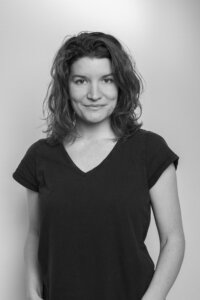
Sarah Louise Kinsella is a photographic and sculptural artist based in Australia exploring concepts of identity.
Creating visual narratives focused on the intimacy of desire through photographic and sculptural constructs, Sarah’s photographic essays are a glimpse into the authentic self of her subjects (from her perspective). Her images often distract the viewer with tensions of nudity, bodily freedom and performance. Sarah’s interested in the role fashion plays in forming people’s identities as she creatively and visually narrates the perception of her subjects (a curiosity influenced by her career as Creative Director – Louise Agency).
–
Samuel Barrie’s roots belong to Sierra Leone. Moving to Australia at the age of four, he’s never lost clarity of his identity. A strong and confident individual, we explored his structural expressions and physical form.
Prior to working together, I met Samuel in person at a cafe.
The first question he asked me was, “Have you ever photographed black skin before?”.
“No, I haven’t”, I replied hastily.
Embarrassed that I hadn’t, an enormous feeling of guilt consumed me.
Seemingly unfazed, Samuel began to describe nuances in lighting, colours and the difference between photographing his skin versus a person with white skin.
This was my lesson.
He had my full attention.
We’re sitting at this small table in the cafe, and Samuel continues to tell me about how he enjoys the form of dance. He suddenly gets up from his chair, moves it out the way and proceeds to show me structural movements using his body on the cafe floor.
I was totally mesmerised!
The visuals I captured are a direct response to my learnings from Samuel.
The orange vibrance enhances the intricacies of Samuel’s figure, where the green light soaks into the highlights of his skin, emphasising his features.
It was my honour to capture this celebration of identity.
Teddy Horton
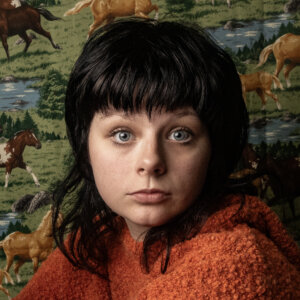
Teddy Horton is a photographer and digital media artist based in Queensland, Australia.
Through her precisely crafted, one-hundred percent AI-generated short video works, Horton subverts character stereotypes and storytelling expectations. Her work is disarmingly funny and poetic, while applying an ironic and self-reflexive lens on the inherent tension of creating art using generative AI.
Horton’s AI video piece ‘Stars Align’ won the Emerging Artist category at the 2024 Queensland Regional Arts Awards. Her digital collage works featured in the 2023 Horizon Festival, and her photographic portrait ‘Rabbit Phone’ was Highly Commended in the 2021 Next Gen Brisbane Portrait Prize.
As a creator, advocate, and critic deeply engaged in the world of generative AI, my practice embraces both the incredible creative potential and the vexed controversies that surround these rapidly evolving platforms.
The Reaper dives headfirst into the cultural rollercoaster that is 2025 America. It poses big questions about the relentless industrial harvesting of artists’ work to feed generative AI engines, but it is also a joyous celebration of creativity.
The creative process is experimental and iterative, prompting, training, editing, and refining content across several platforms. Rather than trying to simulate realism, the work actively highlights and celebrates generative AI’s limitations and mistakes.
Generative AI platforms are reshaping arts practice in fundamental ways, and there is an opportunity to inform its development through analysis of the history of technologies like photography. Inspired by photo colourisation techniques from 1850s Japan, The Reaper combines AI-generated black and white images with manual colouring techniques. The still images are animated into short video sequences and edited to an AI-generated music track.
The experimental format and cinematic style reference elements of feature film trailers and long-form advertising. The disjointed, dream-state narrative deliberately mixes eras and settings. The nostalgic black and white aesthetic and the playful exploration of clichéd male narratives surprise us, but ultimately reinforce gender stereotypes.
Whilst we celebrate the Reaper’s success, there is a sense of unease, amplified by a realisation that, although we read The Reaper as a single character, each iteration is actually unique. The 1970s Las Vegas streetscapes, showgirl imagery, and ‘yacht rock’ soundtrack remind us that these consumer-driven traditions have long histories in the arts and entertainment industry.
Jake Preval

Jake Preval is a visual artist living and working in Naarm (Melbourne). His latest work, Monolith with Joel Bray Dance, debuted at RISING Festival in June 2025. He holds a Master of Fine Art (Visual Art) from the University of Melbourne. His work has been shown across Australia and New Zealand, including as a finalist in the John Fries Award, Tom Bass Figurative Sculpture Prize, and Woollarah Small Sculpture Prize. In 2022 he won a Green Room Award for his production design of Phillip Adams Balletlab’ SICK. He is represented by Sarah Scout Presents, Melbourne.
Preval’s expanded sculptural practice uses photography, video, objects and performance to explore the rituals and intimate enactments of queer desire, centring on the body as a site of the surreal and the sublime. Often engaging sex – and the materials of sex – his work operates at the intersection of humour, celebration, and social critique. Moving freely between the monumental and the mundane, he is particularly interested in how erotic and social relations might be articulated through a material practice. Through extended studio processes that isolate, distort, and re-cast images, objects, and detritus from popular culture, combined with his own personal narratives and mythologies, he playfully teases out complex ideas about contemporary queerness, desire, eros, and the body.
Bloom continues these explorations, and renews the artist’s engagement with dance, working with trained dancers in what Preval describes as ‘an orgiastic sublime, a Bacchanalian dance, a tender queer happening’. Masked in the faces and limbs of Preval’s friends and lovers and scored by his dream-like composition, the cardboard-clad bodies double, writhe, and collapse into each other. Filmed from both front and back simultaneously, the mechanics of both costume and movement are revealed.
Jack Hodges
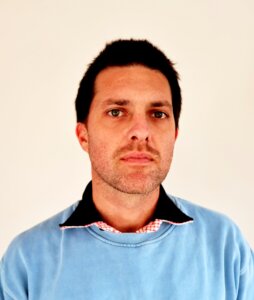
Jack Hodges is a multidisciplinary artist based on Gumbaynggirr Country in Nambucca Heads, NSW. His practice centres on the intersection of materiality, place, and social critique. He is interested in everyday aesthetics, local culture, and the deeper truths revealed through irony and imperfection. Hodges seeks to shed light on the quiet forces influencing our daily lives: coercion, convention, coexistence, and status, prompting reflection on how these pressures guide our decisions. Hodges completed a Master of Community Development in 2020, informing his use of problem-posing methods to generate dialogue and reinterpret public interactions into artworks.
People’s Choice is a response to the growing polarisation across political, cultural, and social spheres. At a time when echo chambers dominate both digital and real-world spaces, this work asks: What stops those seeking meaningful change from engaging with contrasting perspectives? Rather than providing answers, the project facilitates conversation to interrogate thought, embracing uncertainty over certainty, curiosity over conviction.
At its heart is a 21-minute film, following Gary the Dolphin, a laid-back human-porpoise hybrid, embodying the existential paradox of freedom. As a silent witness to deeply held assumptions, he serves as a medium for collective reasoning. Gary is a figure caught between worlds, land and sea, urban and rural. As someone who’s never left Nambucca Heads, his identity is shaped not just by place, but by the people he encounters.
Gary’s car, a wrecked cardboard Ferrari Testarossa, stands as a monument to the illusion of freedom and the fragility of control. A symbol of speed, status, and individualism now rendered still and broken, a collision of desire and consequence. Does one truly steer their own life, or are they being driven in directions out of one’s control?
People’s Choice is the first in a 3-part series, exploring how beliefs are formed, held, and challenged. Episode 1 focuses on individual freedom and the boundaries of choice. The series invites the public to reflect on the forces shaping everyday decisions, not in isolation, but in relation to each other.
Emma Rani Hodges

Emma Rani Hodges lives on the unceded lands of the Ngunnawal and Ngambri peoples. They are ฉันเป็นลูกของ ไทย ออสเตรเลียน ‘Chan pen luk khrueng Thai Australia’. Which in English translates to ‘I am the child of Thailand and Australia’. Hodges’s practice explores intergenerational trauma, community building, migration, and multiethnic identity through an autoethnographic framework. They do this through mixed media, textiles, and storytelling, utilizing ambiguous materiality to examine social boundaries. Hodges uses their feelings of otherness to create new self-knowledge, while acknowledging that the existence of the ‘other’ depends on specific political conditions that influence relationships between marginalised bodies and society.
‘I’m more, I’m not forgotten parts’ is an installation that explores memory, migration, and mythology. In this installation, Hodges kills and cannibalizes their old artworks and then reincarnates them. This is a process of remembering, ripping, cutting, and eventually repairing alongside making new parts. Hodges works with the philosophy that memory can be stored in objects, recalling their cultural connection to animism. The pieces of fabric that make up this installation all lived lives before arriving in Australia. Some of the scrap fabric belonged to Hodges’s grandmother, who was a seamstress in Nonthaburi. These scraps came from a place where ancestor worship and care for ghosts are embedded in everyday practice. Hodges painted a Cerberus, a three headed dog who’s a guardian and gatekeeper of the underworld. He stops the dead from leaving and the living from entering. Below the Cerberus, Hodges has placed the words “above me is a heart, ready to cross an ocean”. Like the Department of Home Affairs, Cerberus exists in a position of power and controls movement across borders. The Cerberus stands at the entrance of a spirit house. As a child, Hodges was taught that these houses are shelters for spirits that will cause chaos if they’re not appeased. In ‘I’m more, I’m not forgotten parts’ Hodges has depicted a Thai ghost known as a Krasue. They appear as floating, dismembered women, with organs such as hearts and lungs drifting behind them. These are women who are seen as perpetual outsiders who have been condemned by society for committing ‘sin’. Hodges hopes that their spirit house will shelter the Krasue, and that she can find a safe home, like we all deserve. For Hodges, this installation is a place for souls to rest and for their childhood memories and fear of ghosts to take a physical form.
Joseph de la Hoyde
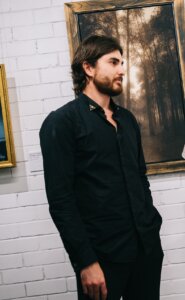
Joseph de la Hoyde is a Sydney-based multimedia artist whose practice centres around painting, photography, and collected forms to document a ritualistic connection to the seen and unseen world. Drawn to allegory, sacrality, and Gothicism, his work ambles between darkness and light, where ethereal veiled figures, disquieting natural landscapes, and intimate meditations on mortality converge. His work invites his audience into a world of thresholds – otherworldly yet familiar, tender and macabre, creating moments where wonder, disillusionment, transcendence, and disquiet go hand in hand.
Joseph has exhibited works in solo and group shows, winning awards in subsequent years in the ‘Digital Stills’ and People’s Choice Categories in the Hornsby Art Prize 2023/2022 as well as being a finalist in the Du Rietz Art Prize in 2022 and Hornsby Art Prize 2019. His works have been featured in international art blogs and journals, including Beautiful Bizarre Magazine and Unvael Journal.
When my wife became a mother, she woke to motherhood as though an owl visited her in her sleep, the light inside her transfiguring into a force only she could understand. She nurtured our new daughter, nursing her, bathing her, rocking her gently to sleep each night, listening to her body as it divulged all the secrets to motherhood. The owl, in my allegory, is the wisdom of her body, visiting her each night to remind her that she does not need to learn how to become a mother; she has always been one in the ageless world.
Having practiced primarily as a conceptual photographer for most of my career, this painting marks a desire to continue the ideas found in my photography work within a more traditional format, exploring a connection to historical practice and allegory. Inspired by the ability of mythology to underpin universal truths, I seek to create new mythologies based on the contemporary urge to feel everything whilst accepting that we know nothing. My subjects are veiled from themselves, their desires, and the world around them, in touch with the divine only through their longing to reconnect to it. My work, largely underpinned by my conceptual photography practice, seeks to affirm the ability of my subjects to exist simultaneously within our contemporary world and within a world where the answers to the questions we seek are much less important than the act of wondering itself.
Donina Asera
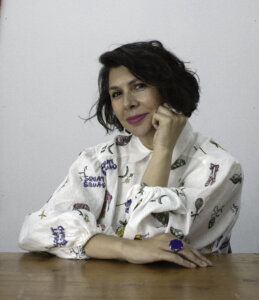
Melbourne-based artist Donina Asera creates vibrant mythological narratives through distinctive visual storytelling. As a first-generation Australian with Dutch and Samoan heritage, she incorporates cultural elements into patterns that form her visual language. Her signature style features flat, abstracted landscapes populated by God-like figures and creatures. Donina has gained recognition as a finalist in several art prizes, including the prestigious Sir John Sulman Prize 2025. She has exhibited in a solo exhibition, multiple group shows, and art fairs across Australia.
Donina’s work appears in private collections across Australia, Europe, and the US. She maintains a studio in Melbourne.
I’ve always been captivated by mythology across cultures, and my work explores a created mythology with gods and goddesses in an imagined realm. These gods are woven through my visual stories like characters in a book, appearing on flat, abstracted landscapes that seem stage-like, with beings caught mid-act. My artistic process combines pattern-making and intuitive mark-making, working predominantly in acrylic with pencil and charcoal elements. My technical approach involves building multiple textural layers, selectively adding and subtracting to reveal underlying colours and patterns
In the Garden shows a solitary god inhabiting a sacred space, bearing witness to the unfurling of a single bloom. This piece from my Idle Divine series contemplates the everyday humanity within divinity. Rather than depicting gods in their traditional omnipotent roles, this body of work reveals gods in states of quiet contemplation and ennui, removed from their cosmic responsibilities. This work is a meditation on presence and wonder, suggesting that even gods find meaning in life’s most ephemeral moments.
Lilli Waters

Lilli Waters’ photographs can be considered autobiographical landscapes, depicting women within the natural environment to deconstruct historical perspectives, subverting the monolithic male gaze and re-contextualising what has been lost within patriarchal structures. Water is a recurring motif that carries through her images, acting as a thread supporting notions of rebirth and renewal.
Her artworks have been awarded the Julia Margaret Cameron Award and the Du Rietz Art Award and have been selected as finalists in the Ravenswood Australian Women’s Art Prize, Nillumbik Prize for Contemporary Art, Fisher’s Ghost Art Award, Percival Photographic Art Prize, National Portrait Prize, Australian Photography Awards, and the Aesthetica Art Award. In 2023, her moving image works were exhibited at Sydney Contemporary, Carriageworks.
Lilli Waters is a contemporary photographic artist living and working on Wurundjeri Country, Australia. She has been exhibiting her work across Australia, Italy, Germany, Japan, the UK, and the US since 2012.
‘Maelstrom’ is inspired by the iconography of ancient Greek and Roman mythology, folklore, and religious painting. It recasts the contemporary woman as a powerful goddess of nature, a portrayal of femininity to be celebrated, embraced, and revered.
God-like, enigmatic female figures are submerged within a dramatic, watery cloudscape inside the mystical Tidal River on Yiruk Wamoon, the land of the Boonwurrung, Bunurong, and Gunaikurnai people. They portray existential dualities of light and dark, traversing a portal into an unknown realm of fear, discomfort, and longing for connection and transformation.
Dishevelled red hair trails through ominous waters like blooms of algae, symbolising untethered femininity: powerful and dangerous. The maelstroms in which these figures swirl become both vortex and refuge, pathways toward enlightenment. Immersed in the storm’s circular rhythm, they rise and fall, concealed and revealed in an endless cycle of shimmering stardust.
These angelic beings emerge from below, disappear, and resurface with new awareness. Troubling yet luminous, they glisten under the golden sun, swirling in harmony with the heaving currents, sensing an unknown fate. They are sensual, disarming gatekeepers, rulers of the underworld, dancing in ancient rituals in the day’s playful hours. The whirlpool’s brooding surge carries a quiet unease, yet the figures are empowered, not resistant. They are nature: interconnected, elemental, and unafraid.
Tory Epworth

Tory Epworth is a Sydney artist known for her minimalist light sculptures created from acrylic sheet and glass. Her work explores the interplay of light, colour, and form, resulting in striking three-dimensional compositions that blur the boundaries between sculpture and installation.
Epworth’s art is a natural extension of her career in digital innovation and experimental design. Prototypes and iterative design are central to her art process – tinkering, exploring, testing, and refining.
Epworth’s work has been recognised nationally, as a finalist in the 2023 Woollahra Small Sculpture prize, 2024 Omnia Art, and 2024 BDAS sculpture prizes.
In the Convex / Concave series, I use a transparent acrylic sheet normally used in retail signage. Cut into blades and methodically arranged, their luminous edges absorb ambient light.
I am drawn to the minimal form and repeated pattern. Within these constraints, I look for a kind of rupture—a kink in the system, a softness in the grid. I want this work to feel poised between stability and disorientation. Movement is key, both literal and perceptual: light shifts, colours refract, edges dissolve.
Beyond the optics, it’s also about systems of seeing, and the patterns that govern experience. Each piece is an invitation to pause, to look again, to consider what’s in plain sight.
This exhibition is presented in partnership with the churchie emerging art prize
Hero image and documentation images courtesy of Dan McCabe (@artdoc_au)























